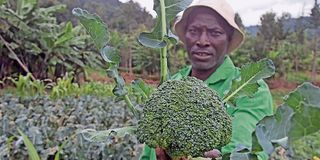Agronomist notebook: How to keep clubroot off your crops

Samuel Muriithi on his broccoli farm in Nyeri. Before planting the plant's seedlings, it’s vital to inspect them for any signs and symptoms of clubroot disease as this prevents it's introduction on the farm. PHOTO | FILE | NATION MEDIA GROUP
What you need to know:
- Nematodes hardly affect the brassicas, hence clubroot galls should not be confused with nematodes.
- The outer leaves turn yellow or brown. Developing plants may not show any symptoms but as they get old, they show stunted growth.
- Mostly, the disease first appears scattered in the farm but in the subsequent season, it may affect the entire field.
- The fungus can persist in the soil for long, hence the need to carry out crop rotation with non-brassicas such as onions.
Recently, a farmer posted on a WhatsApp group a picture of broccoli crops whose roots had clubs similar to those of nematodes.
He lamented how his entire acre of broccoli had developed similar symptoms. The crop would wilt during the day and eventually die while still young. After uprooting the crop, galls would easily be seen on the root systems.
These are symptoms of clubroot disease, which affects the brassica family. This includes cabbages, broccoli and cauliflower.
Nematodes hardly affect the brassicas, hence clubroot galls should not be confused with nematodes.
It is a soil-borne fungal disease caused by Plasmodiophora brassicae. The fungal infects susceptible crops such as kales or cabbages through their root hairs.
The roots swell and deform, which makes it difficult for the plant to absorb water and nutrients efficiently.
In most cases, plants grow poorly and wilt during the day, especially when hot, and revive during the cool nights.
The outer leaves turn yellow or brown. Developing plants may not show any symptoms but as they get old, they show stunted growth.
The small galls are seen on the secondary roots. In most cases, the clubbed roots are firm and tend to be lightly coloured during the early stages of crop growth.
High infestation can easily result in total crop failure as the roots turn black and decay by the end of the crop season.
Mostly, the disease first appears scattered in the farm but in the subsequent season, it may affect the entire field. The disease can easily be spread by wind, water and disinfected tools and equipment used on the farm.
EXCESS MOISTURE
The disease best develops in excess moisture and when the soil pH is low. Ensure you get certified seeds that are resistant to the disease as this reduces the chances of attack.
If buying the seedlings, make sure you acquire them from a reputable seedlings producer and make sure they are free from disease.
Before planting the seedling, it’s vital to inspect them for any signs and symptoms of the clubroot as this prevents disease introduction on the farm.
Ensure the farm is always clean. Disinfect the tools and equipment used on the farm using sodium hypochlorite or hydrogen peroxide before using them.
The fungus can persist in the soil for long, hence the need to carry out crop rotation with non-brassicas such as onions.
In greenhouse production, methods of soil treatment such as soil solarisation help to kill the fungus. Soil solarisation is done by leaving a clear plastic polythene sheet on the soil surface for four-to-six weeks during the hot season.
This kills both beneficial and harmful microorganisms in the soil. Soil solarisation should be done before planting.
Control the growth of weeds such as mustard that are susceptible to the disease.
Raise the soil pH by adding lime in the soil as the fungus does not thrive in high pH; that is, alkaline soils.
The fungus can also spread through irrigation water; therefore ensure you use clean water for irrigation.
Consider your soil type as this is an important factor in the development and spread of cabbage clubroot.
For instance, the use of sand will allow plants to grow in well-drained soil, thereby eliminating the possibility of the pathogen thriving in a conducive environment, unlike in clay soil, which has high water retention ability.
Before planting, it’s also important for farmers to conduct soil test analysis, as this would help them determine the presence of the pathogen, hence avoid planting the brassica in the same field.





